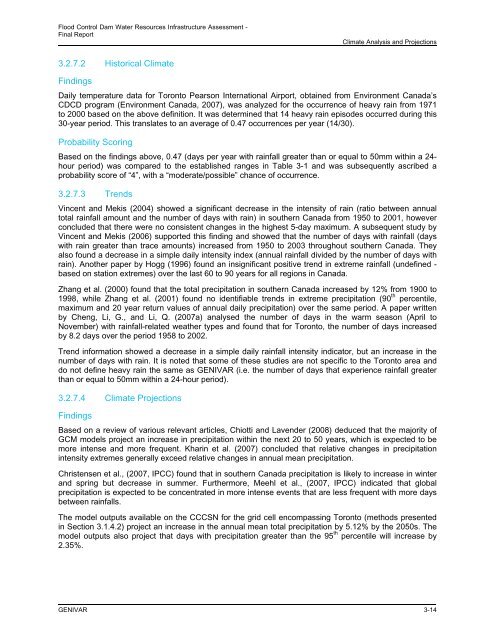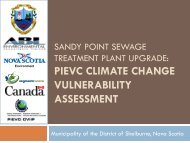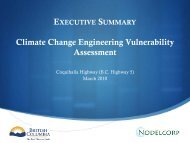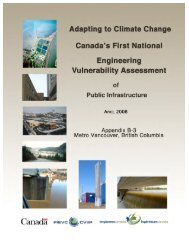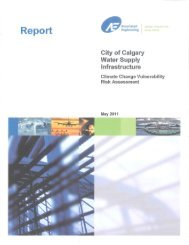Final Report - Vulnerability Committee
Final Report - Vulnerability Committee
Final Report - Vulnerability Committee
Create successful ePaper yourself
Turn your PDF publications into a flip-book with our unique Google optimized e-Paper software.
Flood Control Dam Water Resources Infrastructure Assessment -<strong>Final</strong> <strong>Report</strong>Climate Analysis and Projections3.2.7.2 Historical ClimateFindingsDaily temperature data for Toronto Pearson International Airport, obtained from Environment Canada’sCDCD program (Environment Canada, 2007), was analyzed for the occurrence of heavy rain from 1971to 2000 based on the above definition. It was determined that 14 heavy rain episodes occurred during this30-year period. This translates to an average of 0.47 occurrences per year (14/30).Probability ScoringBased on the findings above, 0.47 (days per year with rainfall greater than or equal to 50mm within a 24-hour period) was compared to the established ranges in Table 3-1 and was subsequently ascribed aprobability score of “4”, with a “moderate/possible” chance of occurrence.3.2.7.3 TrendsVincent and Mekis (2004) showed a significant decrease in the intensity of rain (ratio between annualtotal rainfall amount and the number of days with rain) in southern Canada from 1950 to 2001, howeverconcluded that there were no consistent changes in the highest 5-day maximum. A subsequent study byVincent and Mekis (2006) supported this finding and showed that the number of days with rainfall (dayswith rain greater than trace amounts) increased from 1950 to 2003 throughout southern Canada. Theyalso found a decrease in a simple daily intensity index (annual rainfall divided by the number of days withrain). Another paper by Hogg (1996) found an insignificant positive trend in extreme rainfall (undefined -based on station extremes) over the last 60 to 90 years for all regions in Canada.Zhang et al. (2000) found that the total precipitation in southern Canada increased by 12% from 1900 to1998, while Zhang et al. (2001) found no identifiable trends in extreme precipitation (90 th percentile,maximum and 20 year return values of annual daily precipitation) over the same period. A paper writtenby Cheng, Li, G., and Li, Q. (2007a) analysed the number of days in the warm season (April toNovember) with rainfall-related weather types and found that for Toronto, the number of days increasedby 8.2 days over the period 1958 to 2002.Trend information showed a decrease in a simple daily rainfall intensity indicator, but an increase in thenumber of days with rain. It is noted that some of these studies are not specific to the Toronto area anddo not define heavy rain the same as GENIVAR (i.e. the number of days that experience rainfall greaterthan or equal to 50mm within a 24-hour period).3.2.7.4 Climate ProjectionsFindingsBased on a review of various relevant articles, Chiotti and Lavender (2008) deduced that the majority ofGCM models project an increase in precipitation within the next 20 to 50 years, which is expected to bemore intense and more frequent. Kharin et al. (2007) concluded that relative changes in precipitationintensity extremes generally exceed relative changes in annual mean precipitation.Christensen et al., (2007, IPCC) found that in southern Canada precipitation is likely to increase in winterand spring but decrease in summer. Furthermore, Meehl et al., (2007, IPCC) indicated that globalprecipitation is expected to be concentrated in more intense events that are less frequent with more daysbetween rainfalls.The model outputs available on the CCCSN for the grid cell encompassing Toronto (methods presentedin Section 3.1.4.2) project an increase in the annual mean total precipitation by 5.12% by the 2050s. Themodel outputs also project that days with precipitation greater than the 95 th percentile will increase by2.35%.GENIVAR 3-14


